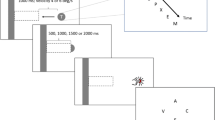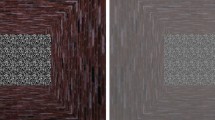Abstract
To estimate the time-to-contact (TTC) of a moving object, numerous studies have focused on the type of information or gaze strategy used by the observer. However, it remains to be determined whether and how attention could affect TTC estimation. In particular, how does TTC estimation operate when less attention is available? To answer this question, we conducted two experiments in which the participants had to perform an absolute (Experiment 1) or relative (Experiment 2) prediction-motion task, either alone (i.e., in single-task condition) or along with a secondary, visual working-memory task (i.e., in dual-task condition). In both experiments, we found that TTC estimation was superior in dual-task condition relative to single-task condition. This finding suggests that the reduction of available attention actually improves TTC estimation. We discuss possible explanations as well as theoretical implications for this seemingly counter-intuitive finding. Further research is needed to investigate if (in)attention facilitates or only shifts TTC estimation.








Similar content being viewed by others
Notes
According to Matthews and Meck (2016), two hypotheses may explain why attention may influence the clocking strategy: because an attentional gate controls the flow of pulses from a pacemaker into an accumulator, or because attention determines the latency with which the flow of pulses begins after the stimulus onset.
Because TTC can be both an independent variable (the occlusion time applied to the moving object) and also the dependent variable that has to be judged (the moment the object is thought to arrive at the finishing line), we will refer to actual TTC as being the independent variable and estimated TTC as the judgement of the participants.
According to Läkens (2013), “CL effect size expresses the probability that a randomly sampled person from one group will have a higher observed measurement than a randomly sampled person from the other group (for between-designs) or (for within-designs) the probability that an individual has a higher value on one measurement than the other”.
References
Allen R, McGeorge P, Pearson D, Milne AB (2004) Attention and expertise in multiple target tracking. Appl Cogn Psychol 18:337–347
Barouillet P, Bernardin S, Camos V (2004) Time constraints and resource sharing in adults’ working memory spans. J Exp Psychol Gen 133:83–100
Barouillet P, Bernardin S, Portat S, Vergauwe E, Camos V (2007) Time and cognitive load in working memory. J Exp Psychol Learn Mem Cogn 33:570–585
Baurès R, Hecht H (2011) The effect of body posture on long-range time-to-contact estimation. Perception 40:674–681
Beilock SL, Carr TH, MacMahon C, Strakes JL (2002) When paying attention becomes counterproductive: impact of divided versus skill-focused attention on novice and experienced performance of sensorimotor skills. J Exp Psychol Appl 8:6–16
Benguigui N, Bennett SJ (2010) Ocular pursuit and the estimation of time-to-contact with accelerating objects in prediction motion are controlled independently based on first-order estimates. Exp Brain Res 202:327–339
Bennett SJ, Baurès R, Hecht H, Benguigui N (2010) Eye movements influence estimation of time-to-contact in prediction motion. Exp Brain Res 206:399–407
Bootsma RJ, Oudejans RR (1993) Visual information about time-to-collision between two objects. J Exp Psychol Hum Percept Perform 19:1041–1052
Bosco G, Monache D, Gravano S, Indovina S, La Scaleia I, Maffei B, Zago VM, Lacquaniti F (2015) Filling gaps in visual motion for target capture. Front Integr Neurosci 9:1–17
Chauvel G, Maquestiaux F, Ruthruff E, Didierjean A, Hartley AA (2013) Novice motor performance: better not to verbalize. Psychon Bull Rev 20:177–183
Cohen NJ, Squire LR (1980) Preserved learning and retention of pattern-analyzing skill in amnesia: dissociation of knowing how and knowing that. Science 210:207–210
DeLucia PR (2005) Does binocular disparity or familiar size override effects of relative size on judgments of time to contact? Q J Exp Psychol 58A:865–886
DeLucia PR, Liddell GW (1998) Cognitive motion extrapolation and cognitive clocking in prediction motion tasks. J Exp Psychol Hum Percept Perform 24:901–914
Engle RW (2002) Working memory capacity as executive attention. Curr Dir Psychol Sci 11:19–23
Fruchtman-Steinbok T, Kessler Y (2016) Does working memory load facilitate target detection? Acta Physiol (Oxf) 164:10–18
Hochberg Y (1988) A sharper Bonferroni procedure for multiple tests of significance. Biometrika 75:800–802
Hosking SG, Crassini B (2011) The influence of optic expansion rates when judging the relative time to contact of familiar objects. J Vis 11:1–13
Huynh H, Feldt LS (1976) Estimation of the Box correction for degrees of freedom from sample data in randomized block and split-plot designs. J Educ Behav Stat 1:69–82
Kerzel D (2003) Attention maintains mental extrapolation of target position: irrelevant distractors eliminate forward displacement after implied motion. Cognition 88:109–131
Keselman HJ (1994) Stepwise and simultaneous multiple comparison procedures of repeated measures’ means. J Educ Behav Stat 19:127–162
Krimsky M, Forster DE, Llabre MM, Jha AP (2017) The influence of time on task on mind wandering and visual working memory. Cognition 169:84–90
Lachter J, Forster KI, Ruthruff E (2004) Forty-five years after Broadbent (1958): still no identification without attention. Psychol Rev 111:880–913
Läkens D (2013) Calculating and reporting effect sizes to facilitate cumulative science: a practical primer for t-tests and ANOVAs. Front Psychol 4:1–12
Leavitt J (1979) Cognitive demands of skating and stick handling in ice hockey. Can J Appl Sport Sci 4:46–55
Lee DN (1976) A theory of visual control of braking based on information about time-to-collision. Perception 5:437–459
Linares D, López-Moliner J (2016) Quickpsy: an R package to fit psychometric functions for multiple groups. R J 8(1):122–131
Ling S, Carrasco M (2006) Sustained and transient covert attention enhance the signal via different contrast response functions. Vis Res 46:1210–1220
López-Moliner J, Field DT, Wann JP (2007) Interceptive timing: Prior knowledge matters. J Vis 7:1–8
Lugtigheid AJ, Welchman AE (2011) Evaluating methods to measure time-to-contact. Vis Res 51:2234–2241
Makin ADJ (2017) The common rate control account of prediction motion. Psychon Bull Rev. https://doi.org/10.3758/s13423-017-1403-8
Makin ADJ, Bertamini M (2014) Do different types of dynamic extrapolation rely on the same mechanism? J Exp Psychol Hum Percept Perform 40:1566–1579
Makin ADJ, Chauhan T (2014) Memory-guided tracking through physical space and feature space. J Vis 14:1–15
Makin ADJ, Poliakoff E (2011) Do common systems control eye movements and motion extrapolation? Q J Exp Psychol 64:1327–1343
Matthews WJ, Meck WH (2016) Temporal cognition: connecting subjective time to perception, attention, and memory. Psychol Bull 142:865–907
McIntyre J, Zago M, Berthoz A, Lacquaniti F (2001) Does the brain model Newton’s laws? Nat Neurosci 4:693–694
Motoyoshi I, Ishii T, Kamachi MG (2015) Limited attention facilitates coherent motion processing. J Vis 15:1–11
Olivers CNL, Nieuwenhuis S (2005) The beneficial effect of concurrent task-irrelevant mental activity on temporal attention. Psychol Sci 16:265–269
Olivers CNL, Nieuwenhuis S (2006) The beneficial effects of additional task load, positive affect, and instruction on the attentional blink. J Exp Psychol Hum Percept Perform 32:364–379
Peper L, Bootsma RJ, Mestre DR, Bakker FC (1994) Catching balls: how to get the hand to the right place at the right time. J Exp Psychol Hum Percept Perform 20:591–612
R Core Team (2016). R: a language and environment for statistical computing. R Foundation for Statistical Computing, Vienna, Austria. https://www.R-project.org/. Accessed 27 Nov 2017
Schooler JW, Engstler-Schooler TY (1990) Verbal overshadowing of visual memories: some things are better left unsaid. Cogn Psychol 22:36–71
Smith MD, Chamberlin CJ (1992) Effect of adding cognitively demanding tasks on soccer skill performance. Percept Mot Skills 75:955–961
Tresilian JR (1995) Perceptual and cognitive processes in time-to-contact estimation: analysis of prediction-motion and relative judgment tasks. Percept Psychophys 57:231–245
Tresilian JR (2004) The accuracy of interceptive action in time and space. Exerc Sport Sci Rev 32:167–173
Tresilian JR (2005) Hitting a moving target: perception and action in the timing of rapid interceptions. Percept Psychophys 67:129–149
Vickery TJ, Sussman RS, Jiang YV (2010) Spatial context learning survives interference from working memory load. J Exp Psychol Hum Percept Perform 36:1358–1371
Willingham DB, Goedert-Eschmann K (1999) The relation between implicit and explicit learning. Evidence for parallel development. Psychol Sci 10:531–534
Zago M, Bosco G, Maffei V, Iosa M, Ivanenko YP, Lacquaniti F (2004) Internal models of target motion: expected dynamics overrides measured kinematics in timing manual interceptions. J Neurophysiol 91:1620–1634
Zhao H, Warren WH (2015) On-line and model-based approaches to the visual control of action. Vis Res 110:190–202
Acknowledgements
We would like to thank Alice Parmentier, Old Lo, Kévin Michaud and Benjamin Gouyou for their help with data collection.
Author information
Authors and Affiliations
Corresponding author
Ethics declarations
Conflict of interest
The authors declared no conflicts of interest with respect to the authorship or the publication of this article.
Electronic supplementary material
Below is the link to the electronic supplementary material.
Rights and permissions
About this article
Cite this article
Baurès, R., Maquestiaux, F., DeLucia, P.R. et al. Availability of attention affects time-to-contact estimation. Exp Brain Res 236, 1971–1984 (2018). https://doi.org/10.1007/s00221-018-5273-8
Received:
Accepted:
Published:
Issue Date:
DOI: https://doi.org/10.1007/s00221-018-5273-8




